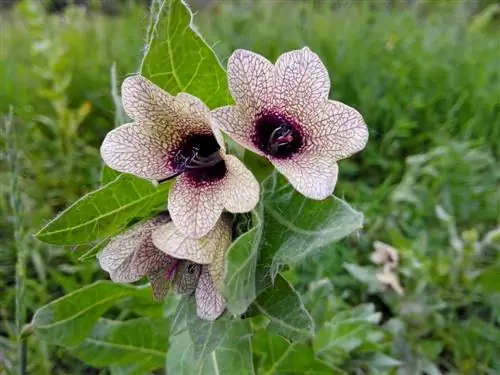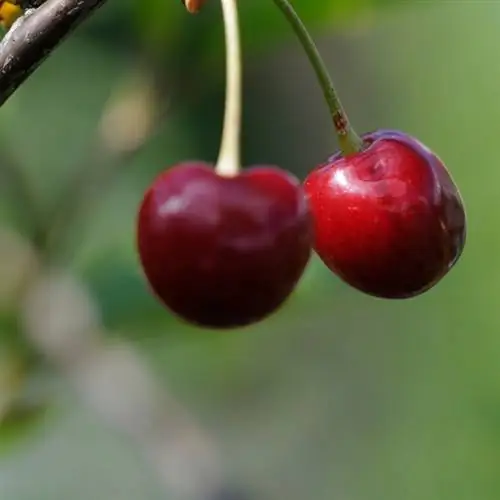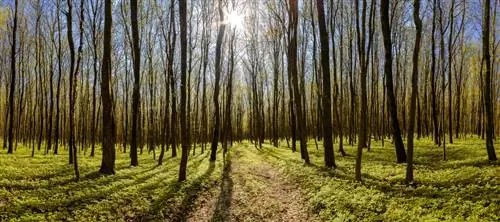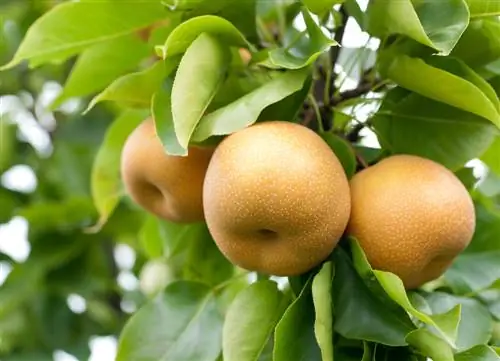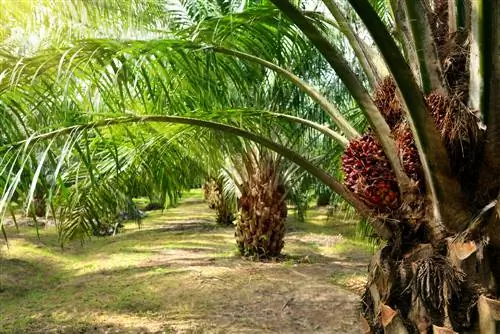- Author admin [email protected].
- Public 2023-12-16 16:46.
- Last modified 2025-06-01 06:02.
Read the commented henbane profile here for important information on growth, ingredients and use. Compact tips and tricks explain how to properly plant and care for Hyoscyamus niger.
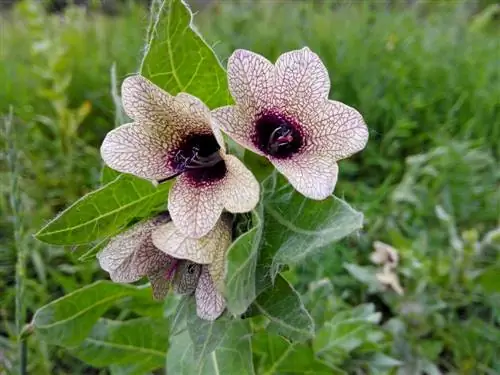
What is henbane and what effects does it have?
The henbane (Hyoscyamus niger) is a highly poisonous plant from the nightshade family. It has elongated egg-shaped leaves and cup-shaped flowers. In homeopathy, henbane can be used for insomnia, nervousness or pain. Attention: All parts of the plant are poisonous, especially roots and seeds.
Profile
- Scientific name: Hyoscyamus niger
- Family: Nightshade family (Solanaceae)
- Synonym: Black henbane, witchweed
- Occurrence: Europe, Asia, North Africa, North America
- Growth type: herbaceous plant
- Growth height: 30 cm to 80 cm
- Leaf: oblong-ovoid
- Flower: goblet-shaped
- Fruit: Capsule
- Toxicity: highly toxic
- Ingredients: Tropane alkaloids
- Use: poisonous plant, medicinal plant, ornamental plant
Growth
Henbane is a short-lived, highly poisonous flowering plant from the nightshade family. As early as the Middle Ages, the herbaceous plant was said to have magical and healing powers, often with serious side effects. In fact, Hyoscyamus niger is closely related to the dreaded belladonna (Atropa belladonna) or the infamous datura (Datura stramonium). Henbane has now become obsolete as a witch's herb and quack plant. The natural beauty has retained its demonic fascination to this day. You can recognize the poisonous plant by these growth characteristics:
- Growth habit: rosette of leaves close to the ground, upright stem.
- Stem: sticky, thinly hairy with leaves surrounding the stem and large funnel-shaped flowers in the leaf axils.
- Height: 30 cm to 80 cm, rarely up to 180 cm.
- Roots: turnip-shaped to a soil depth of 60 cm.
- Life cycle: annual or biennial (depending on the time of germination).
- Occurrence: rubble weed areas, roadsides, ruderal terrain, garbage dumps.
Invisible characteristics of growth are scent and ingredients. Henbane exudes an intense, aromatic smell. In this way, the wild herb has a narcotic and intoxicating effect on sensitive people. All parts of the plant are poisonous. Important ingredients are alkaloids, scopolamine, hyoscyamine, atropine, tannin and tannic acid. The highest concentration of poison is in the roots and seeds.
Video: Botanist explains henbane
Usage
If you pay appropriate respect to the life-threatening poison content and entrust its use as a medicinal plant to an experienced homeopath, you will discover numerous possible uses for henbane. The following table is aimed at hobby gardeners who do not have children or pets in their garden:
| Poison plant | toxic effects | Medicinal plant | Effects | ornamental plant | Design ideas |
|---|---|---|---|---|---|
| Rat poison | deadly | Pain | pain relieving | Cottage Garden | beautiful path border |
| Intoxicants | + respiratory arrest | Nervousness | calming | Herbal spiral | plants in the temperate zone |
| + Hallucinations | Stomach cramps | antispasmodic | Wildflower meadow | associate with wild perennials | |
| + Unconsciousness | Fever | antipyretic | Bee Pasture | Flowering strips for bumblebees | |
| + Coma | Shaking, tremor | dampening | Houseplant | Pot on the bright windowsill |
Already in antiquity and the Middle Ages, medicinal henbane use was strongly discouraged due to the deadly risk of poisoning. Drastic fluctuations in the active ingredient content make exact dosage impossible. Severe poisoning is the fatal consequence of agonizing vomiting and even cardiac arrest. Users become intoxicated for days, which can cause irreversible brain damage and permanent behavioral problems.
Leaf
Before the flowering period begins, henbane is easy to recognize by its distinctive leaves:
- Leaf shape: short-stalked, elongated-ovate, notched, toothed.
- Size: 20 cm to 30 cm long.
- Leaf color: green, dirty-white hairy with sticky glandular hairs.
- Arrangement: as a rosette and stem-encompassing.
Bloom
With its picturesque flowers, henbane sets itself off decoratively throughout the summer. A witchweed flower can be identified by these attributes:
- Flower shape: cup-shaped to funnel-shaped.
- Flower color: dirty whitish-yellow with dark red veining and dark purple throat (grain missing on annual plants).
- ecology: hermaphrodite
- Flowering time: June to October.
- Pollinators: Bumblebees and other long-pronged insects.
Fruit
Pollinated flowers produce bulbous capsule fruits with a length of 1 cm to 1.5 cm. Each fruit is enclosed in an urn-shaped, sticky-glandular calyx up to 4 cm long. Sometimes the calyx lobes are bent back a little and provide a clear view of the pointed or flat capsule cover. Inside a cover fruit there are up to 400 kidney-shaped, gray-brown, 1 mm small seeds. As the fruit ripens between August and October, the calyx enlarges and finally releases the ripe seeds. These seeds are heat germinators and remain viable for up to 600 years.
Excursus
Henbane - healing effects in homeopathy
Hyoscyamus globules relieve numerous complaints without intoxicating and deadly toxic side effects. Experienced homeopaths prescribe henbane use for insomnia, epilepsy, muscle contractions (tics) and even pain, seasickness and hysteria. For self-treatment in acute cases, a homeopathically effective dosage of three to five henbane globules D6 or D12 several times a day is recommended.
Planting henbane
The easiest way to grow henbane in your own garden is to sow seeds. A simple pretreatment makes the seeds ready to germinate. After being grown on the windowsill and planted, the wild herbs start off with a summer flower festival. Read the best planting tips for beds and pots here:
Sowing
In order for the hard-shelled seeds with the biblical shelf life of 600 years to germinate quickly, you need water and a (disused) thermos flask. In it, henbane seeds take a 24-hour warm water bath. For safety reasons, we would like to point out again at this point that sowing and growing the poisonous plant should be done out of the reach of children. Coconut fiber pots are a good choice as a sowing medium. This is how you sow witchweed seeds correctly:
- Best time is in March.
- Place the coconut spring pots in a bowl, pour water over them and let them swell.
- Put the henbane seeds in the middle of a pot and cover them thinly with substrate (light germinator).
- Keep constantly moist on the bright windowsill, do not fertilize.
- Germination time: at 20° Celsius within 14 to 28 days.
Direct sowing is possible in April and May so that the plant flowers in the same year. Later sowing dates until September ensure that henbane thrives as a biennial. In this case, a rosette of leaves forms before winter, from which a strong stem rises next spring.
Location
Henbane thrives best under these conditions:
- Sunny to partially shaded location.
- Fresh, nutrient-rich garden soil with a high nitrogen content.
- Exclusion criteria: waterlogging, sandy-dry soil, acidic pH value less than 5.0.
Perfect pre-culture plants for henbane are natural nitrogen collectors, such as hop clover, white clover or meadow clover.
Planting in the bed
Planting time for early henbane is in April and May. By using the recommended coconut seed pots as a sowing medium, you can plant the seedlings directly into the bed without pricking out. How to do it right:
- Raking and weeding bed soil.
- Dig a planting hole with twice the diameter of the root ball and source pot.
- Mix the excavated material with nitrogen-rich horn shavings as starting fertilizer.
- Plant henbane, press down the soil and water.
When planting in rows, please ensure a planting distance of 60 cm to 90 cm.
Planting in pots
A nitrogen-rich substrate mixture is suitable as a substrate for pot culture. As a base, buy commercially available, peat-free potting soil, which you enrich with compost, horn meal, coconut soil as a peat substitute and lava granules for good permeability. Because waterlogging also reliably kills a poisonous plant, cover the bottom of the pot with broken clay, grit or lava granules as drainage. The procedure for planting in a pot is no different from the planting technique in a bed. Measure the planting depth of witchweed so that a watering edge is created.
Care for henbane
In the right location, henbane is very easy to care for. Demands on water and nutrient supply are sufficient. Only two-year-old plants can overwinter. Read useful care tips for beds and balconies here:
Pouring
The plant evaporates a lot of moisture through its numerous, large leaves. Generous irrigation is therefore a must in gardening. On warm summer days, please check daily with a thumb test whether the soil surface feels dry. If you don't feel any moisture up to 1 cm deep in the soil, your henbane wants to be watered. On hot summer days, this may be necessary daily for potted plants. You can use either tap water or rainwater as irrigation water. Because damp leaves provide a target for mildew, let the water from the watering can run directly onto the soil.
Fertilize
Nitrogen is the engine of growth for henbane. Add a nitrogen-based liquid fertilizer to the irrigation water every month from April to October. You can fertilize bedding plants with either horn shavings or horn meal. Rake in the organic fertilizer a little and water again. Alternatively, spray the root slice regularly with nettle liquid. For an extra dose of nitrogen, occasionally sprinkle the substrate with dried coffee grounds.
Wintering
Sowing and planting henbane in autumn results in two years of growth. In this case, the nightshade plant overwinters as a rosette of leaves in the bed or pot. With these simple precautions you can guide the perennial safely through the cold season:
- Overwinter in the bed: Cover the leaf rosette with leaves and spruce branches.
- Overwinter outside in the pot: Place the container on wood in a protected corner and cover it with fleece or foil.
- Winter indoors in the pot: before the first frost, put away in a frost-free, bright winter quarters, water little by little, do not fertilize.
Remove the winter protection in spring after the last heavy frosts so that the plant can sprout unhindered.
Diseases and pests
Despite all the toxins, henbane is susceptible to various diseases and pests. The following table provides an overview of common damage patterns, lists classic causes and gives tips for ecological countermeasures:
| malicious image | Cause | Countermeasure |
|---|---|---|
| Dirty white surface | Mildew | spray several times with milk-water solution |
| Edge and pitting on the leaves | Potato beetle | Collect beetles, dust with rock dust, Mondamin, coffee grounds |
| Yellow spots, curled leaf edges, sticky coating | Aphids | fight with soap-spirit solution |
| Stunty Growth | Nutrient Deficiency | Administer nitrogen-concentrated liquid fertilizer |
Henbane infested with Colorado potato beetles should be cleared if there is a bed with potatoes, tomatoes, eggplants or other nightshade plants nearby. The danger is too great that the voracious pests will later attack the crops.
Popular varieties
Beyond the native henbane Hyoscyamus niger, these beautiful varieties can be discovered in specialist shops:
- White henbane (Hyoscyamus albus): Mediterranean henbane with white-yellow goblet flowers, growth height up to 90 cm.
- Egyptian henbane (Hyoscyamus muticus): Rarity with violet-pink flowers from May to October, beautiful in the winter garden.
- Bell henbane (Scopolia carniolica): poisonous bellweed with dark red funnel flowers in April and May.
FAQ
Which plant neighbors are suitable for henbane?
Combine henbane with other nightshade plants that place similar demands on the location. These include belladonna (Atropa belladonna), datura (Datura stramonium), mandrake (Mandragora officinalis), black nightshade (Solanum nigrum) and spotted arum (Arum maculatum). All plants are highly poisonous and give the garden a magical, mystical ambience.
How does henbane oil work?
The pain-relieving effect of henbane has been known since the Middle Ages. In naturopathy and homeopathy, henbane oil is therefore prescribed for external treatment of rheumatism and osteoarthritis. Henbane oil is also used to treat scars.
What does henbane have to do with beer?
In the Middle Ages, henbane was often added to beer. The historical drug was intended to increase the intoxicating effects of the alcoholic drink. The Purity Law of 1516 put a stop to this activity. According to a legend, there is a close connection with the cultivation of henbane and the city of Pilsen, where the famous Pilsen beer comes from.
Where can you buy henbane as a plant?
Henbane is usually available as seeds. For understandable reasons, tree nurseries and garden centers do not stock the highly poisonous nightshade plant. We looked around for you and found what you were looking for. At the Rühlemann’s nursery in Horstedt you can buy henbane as a plant in the store or via the online shop kraeuter-duftpflanzen.de at a reasonable price. Black henbane and white henbane are on offer from mid-April to October.
What are the most important identifying characteristics of henbane?
Black henbane is a sticky, hairy plant 30 to 80 cm high. The cup-shaped flowers are located in the leaf axils and are dirty yellow in color with purple veins. The flower throat and the anthers are colored dark red to purple-red. The nightshade plant rarely blooms with pure yellow goblet flowers. Flowering time is from June to October. Egg-shaped capsule fruits with numerous, gray-brown seeds are formed. The cove-toothed leaves form a dense leaf rosette at the base and sit on the upright flower stalk at the top. Henbane is highly poisonous and gives off an intense to unpleasant smell.
Where does black henbane grow?
Henbane occurrences extend from Europe to Asia, from the Iberian Peninsula to the Scandinavian north. Black henbane can be found in North Africa, as well as in North America and Australia. In the Himalayas, the poisonous plant grows up to 3,600 meters above sea level. In our regions, henbane is widespread on nutrient-rich ruderal surfaces, along roadsides and in garbage dumps and rubble storage areas.

